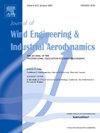Aerodynamic characteristics of windbreak wall–wind barrier transition section along high-speed railways during strong crosswinds
IF 4.2
2区 工程技术
Q1 ENGINEERING, CIVIL
Journal of Wind Engineering and Industrial Aerodynamics
Pub Date : 2025-02-08
DOI:10.1016/j.jweia.2025.106038
引用次数: 0
Abstract
In the embankment–bridge transition section of high-speed railroads, solid windbreak walls and porous wind barriers serve as primary engineering measures to mitigate the effects of strong winds. This study investigates the mechanisms by which the aerodynamic performance of the transition section between solid windbreak walls and porous wind barriers deteriorates. Aerodynamic loads on trains, bridges, and wind barriers are analyzed in this study, which also examines the evolution of flow field characteristics and power spectral density (PSD) across spatial and temporal scales, based on wind tunnel tests, flow visualization tests, and computational fluid dynamics methods. The results reveal that the presence of double-sided wind barriers alters the distribution of turbulence intensity and vortex structures near the bridge–wind barriers compared to single-sided wind barriers. Additionally, double-sided wind barriers greatly increase the aerodynamic loads on trains and bridge–wind barriers compared to single-sided wind barriers. Furthermore, the peak PSD values for bridge-wind barriers with double-sided wind barriers are 1.9–4 times higher than those with single-sided wind barriers. Consequently, the single-sided wind barrier may be a more suitable choice for handling unidirectional crosswinds, considering construction costs and structural safety concerns for both the bridge and the wind barrier.
强侧风作用下高速铁路防风墙-风障过渡段气动特性研究
在高速铁路路桥过渡段,坚固的防风墙和多孔的防风屏障是缓解强风影响的主要工程措施。本文研究了固体防风墙与多孔防风屏障之间过渡段气动性能恶化的机理。基于风洞试验、流动可视化试验和计算流体动力学方法,本研究分析了列车、桥梁和风障上的气动载荷,并研究了流场特性和功率谱密度(PSD)在时空尺度上的演变。结果表明,与单面风障相比,双面风障的存在改变了桥风障附近湍流强度和涡结构的分布。此外,与单面风障相比,双面风障大大增加了列车和桥梁风障的气动载荷。此外,具有双面风障的桥式风障的峰值PSD值是单面风障的1.9 ~ 4倍。因此,考虑到桥梁和风障的建设成本和结构安全问题,单面风障可能是处理单向侧风的更合适的选择。
本文章由计算机程序翻译,如有差异,请以英文原文为准。
求助全文
约1分钟内获得全文
求助全文
来源期刊
CiteScore
8.90
自引率
22.90%
发文量
306
审稿时长
4.4 months
期刊介绍:
The objective of the journal is to provide a means for the publication and interchange of information, on an international basis, on all those aspects of wind engineering that are included in the activities of the International Association for Wind Engineering http://www.iawe.org/. These are: social and economic impact of wind effects; wind characteristics and structure, local wind environments, wind loads and structural response, diffusion, pollutant dispersion and matter transport, wind effects on building heat loss and ventilation, wind effects on transport systems, aerodynamic aspects of wind energy generation, and codification of wind effects.
Papers on these subjects describing full-scale measurements, wind-tunnel simulation studies, computational or theoretical methods are published, as well as papers dealing with the development of techniques and apparatus for wind engineering experiments.

 求助内容:
求助内容: 应助结果提醒方式:
应助结果提醒方式:


